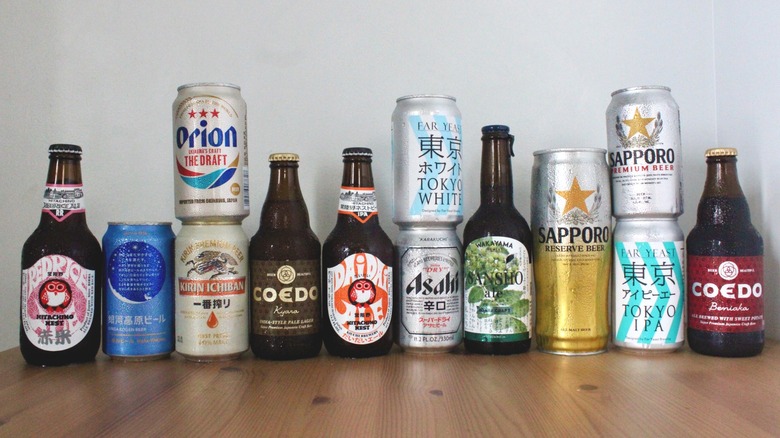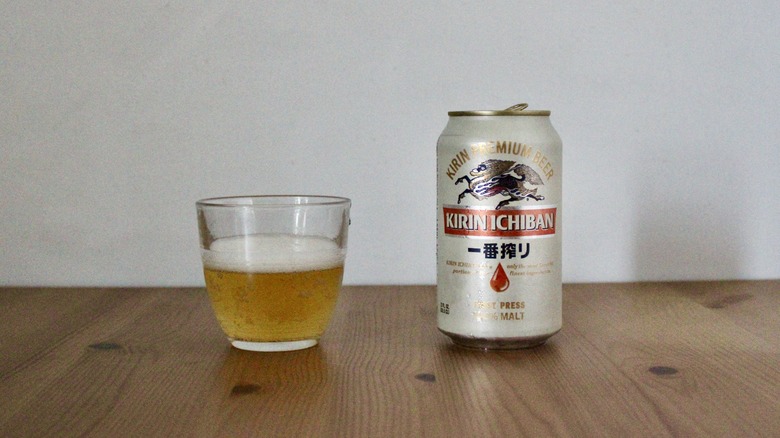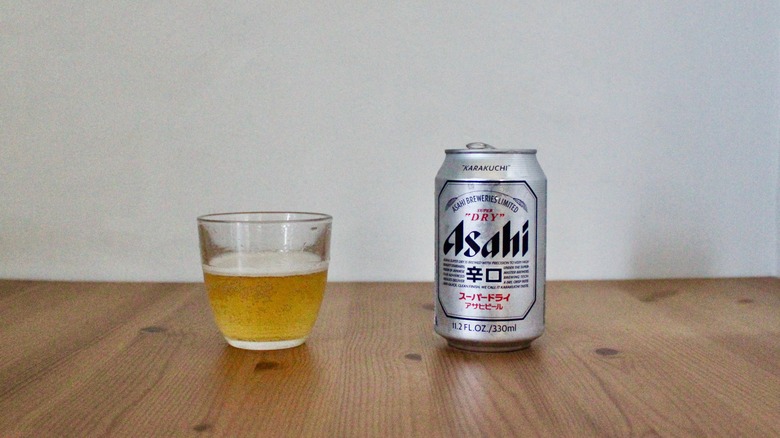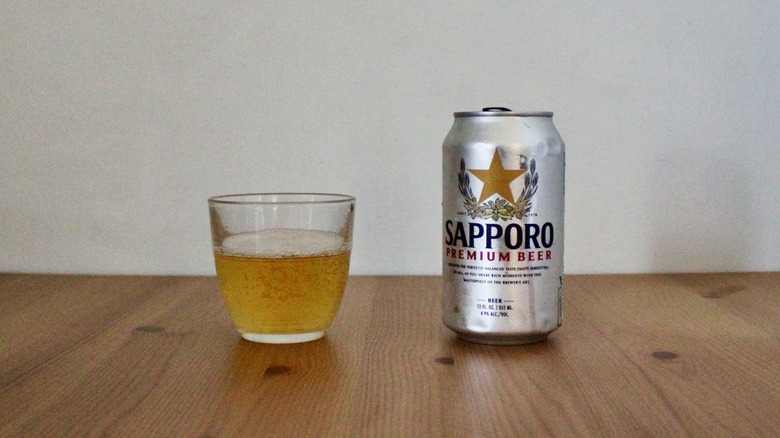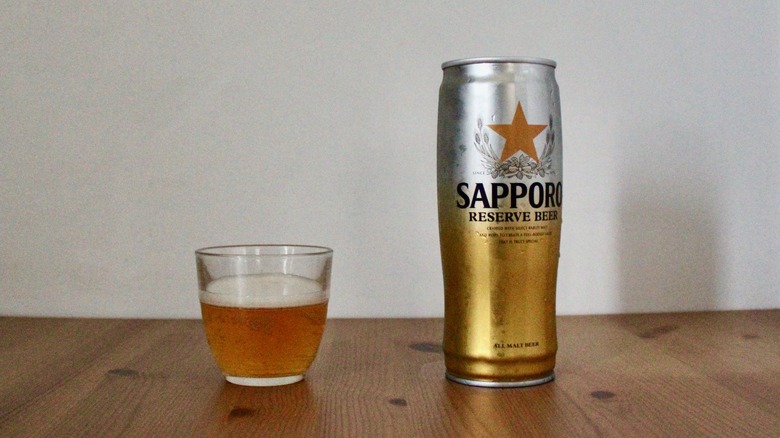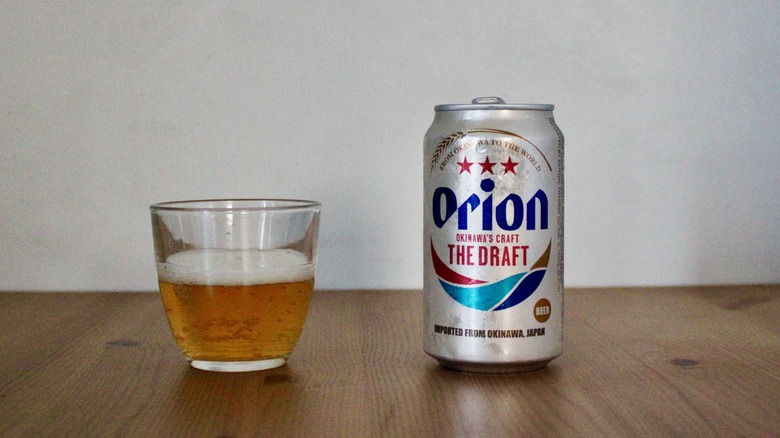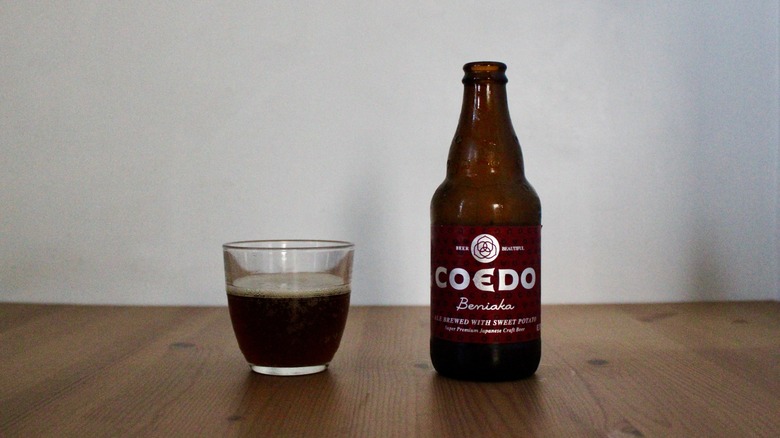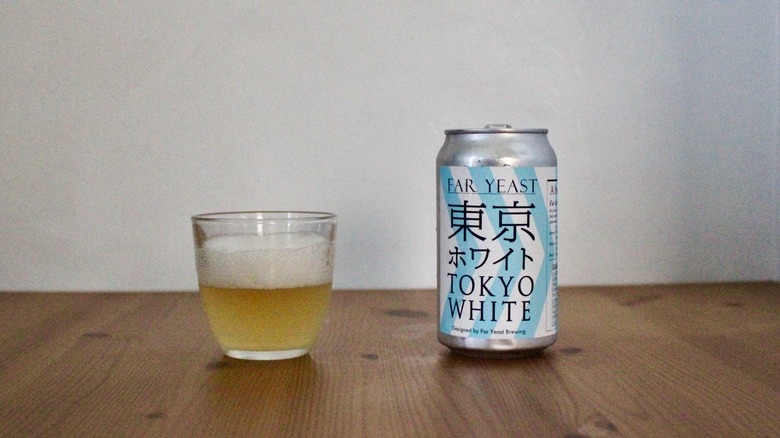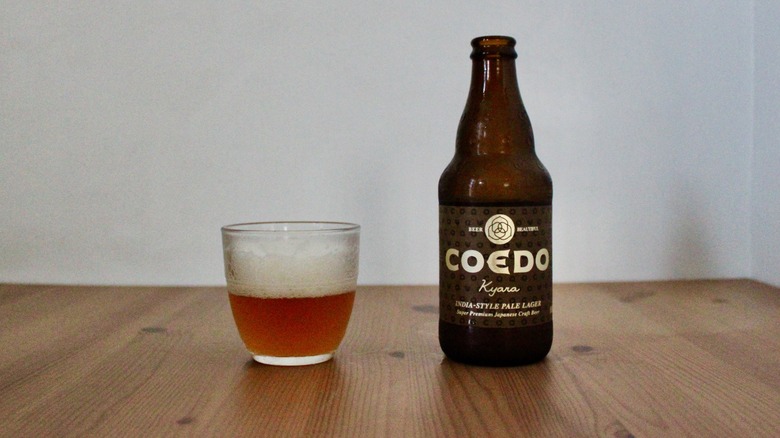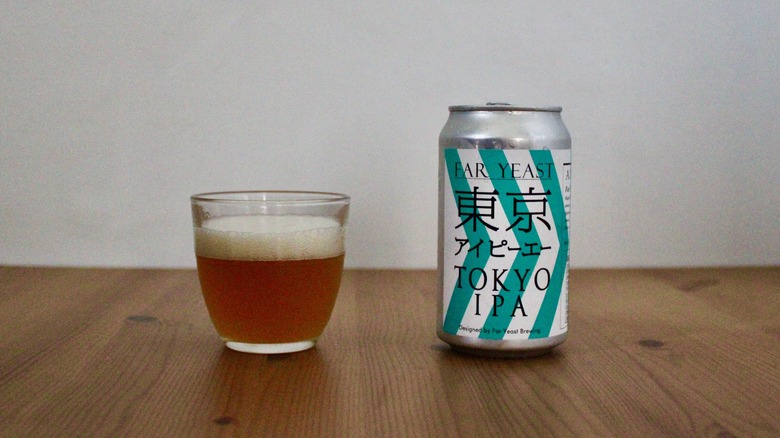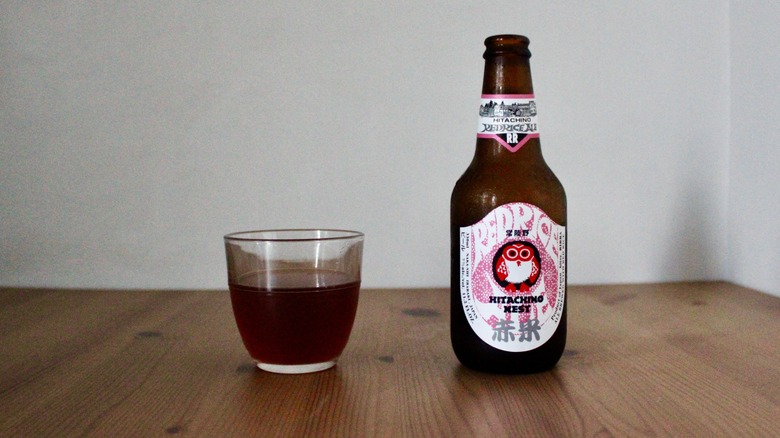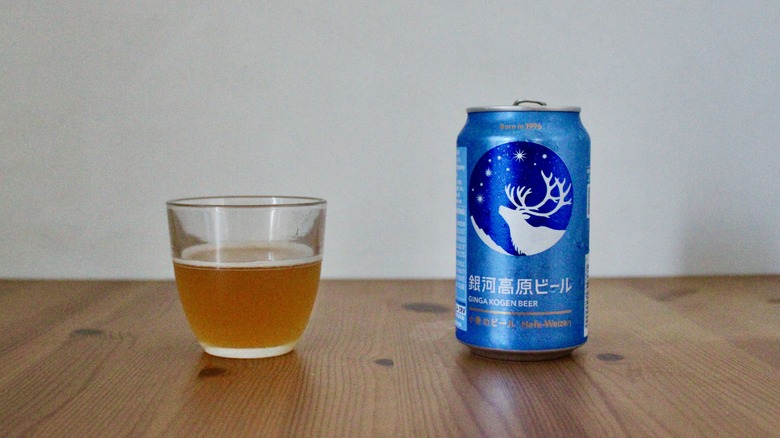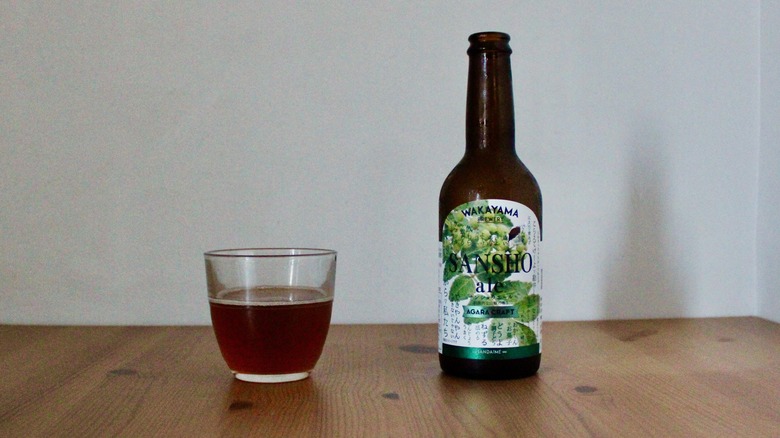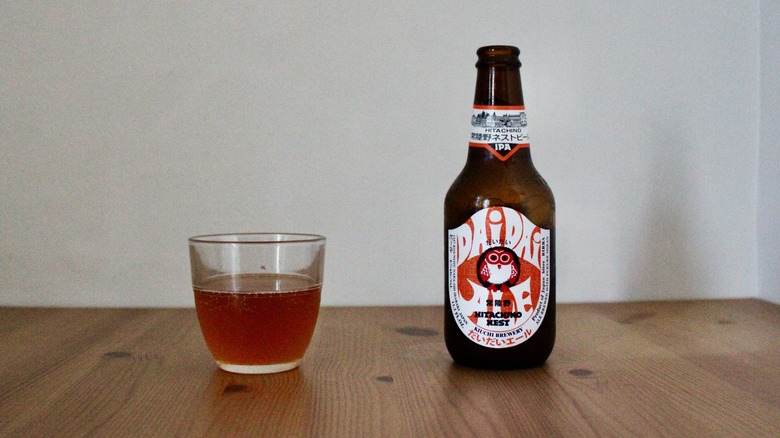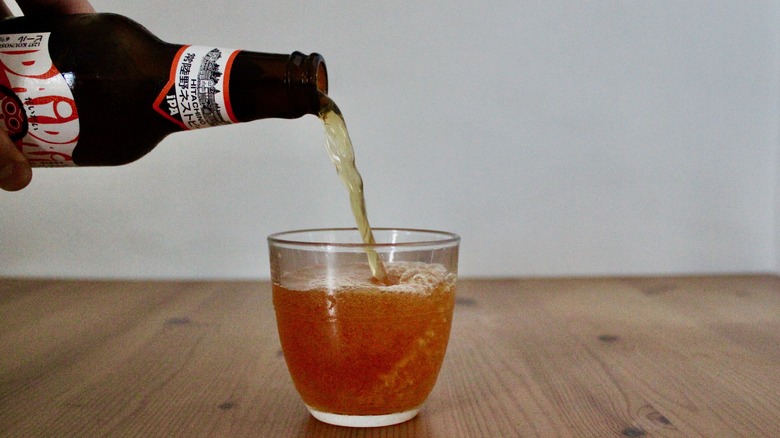13 Japanese Beers Available In The US, Ranked
To beer or not to beer? In Japan, it's a simple answer. Although beer didn't originate in Japan, it's one of the country's most-consumed types of alcohol. While you may have heard of the more popular Japanese beers, there are also so many delicious selections from smaller Japanese breweries that have yet to make their way onto the mainstream beer market in the United States.
I, as a self-appointed beer connoisseur, wanted to sample these brews to determine which were worth buying. When I started my search for Japanese beers, a few New York City beermongers told me that I'd have a hard time finding what I was looking for. This myth was quickly debunked after I walked down the beer aisle of a Japanese grocery store and found a variety of brews. I cast a wide net by collecting beers from large, well-known breweries as well as smaller craft operations.
While beer tasting is largely subjective, there are a few key signs I look for in a quality beer. Since every type of beer is different, they must be evaluated in terms of how well they represent a category. For example, a porter will be a totally different sipping experience than a hefeweizen. I judged each of these beers based on their smell, taste, and flavor balance to identify which Japanese beer brands available in the U.S. are worth trying and which ones you can skip.
13. Kirin Ichiban
Kirin is one of Japan's oldest breweries, but sadly, my taste buds don't account for age. Kirin Ichiban, the brand's flagship beer, has a clear, pale golden color. It foamed up nicely when I poured it in the glass. The head remained intact for a surprisingly long time, which indicates proper carbonation. I also noticed it released a strong malty aroma — which is a good sign. The issue I have with Kirin Ichiban, though, is that it lacks personality.
This beer is mass-produced, and it definitely tastes like it. It lacks not only the refined qualities of a carefully brewed, traditional beer, but also the pizzazz of some of the more creative brews on the list. It has a very light body, which I don't mean as a compliment, but rather a testament to how forgettable the experience was. The flavor is also undercut by a bitter aftertaste that lingers for an unpleasantly long time. Since it's one of the most widely available beers on the list, it's easy to find at most Japanese restaurants. But, I'd recommend one of the other popular lagers on the list if you're looking for easy sipping at dinnertime.
12. Asahi Super Dry
Asahi claims to be "the world's first super dry beer." Super dry beer is fermented in a way that leaves very little residual sugar, meaning that the beer has very little sweetness. When I poured it into a glass, I saw how the pale, golden yellow liquid gave rise to a white, creamy head. The bubbles emitted an aroma that's cleaner and a little less malty than the other lagers on the list. This may be due to the fact that Asahi Super Dry is brewed with rice, in addition to barley, hops, and yeast.
Asahi Super Dry has a smooth, crisp finish, but not a whole lot of noticeable flavor. I was disappointed by the aftertaste, which was a bit bitter and lingered longer than I'd like. This wouldn't have been as much of an issue if I'd been drinking this beer with dinner, especially if there were spicy, bold flavors on the menu that would contrast the beer's light effervescence. Many folks even say a light lager like Asahi is the best kind of beer to pair with sushi, but if you're a beer lover who wants a brew that can hold its own, you'll be disappointed with this selection.
11. Sapporo Premium
If you're a beer drinker who eats at Japanese restaurants often, you're probably familiar with Sapporo Premium. This lager-style beer, and the brand's flagship brew, is affordable and easy to come by in the U.S. As a whole, it's pretty unremarkable. When I poured it into the glass, an attractive pale yellow liquid formed a head of irregularly sized bubbles. It wasn't the nice, uniform foam I look for in a quality beer. The head collapsed almost immediately and barely gave off any aroma. When I really stuck my nose in there, I got a hint of maltiness and a touch of grain, but the scent was surprisingly weak overall.
In terms of taste, Sapporo is nothing special. Some say that Sapporo is the absolute best beer to pair with ramen – and it does have a light body that would the salty, umami flavors in the dish well. If you're looking for an inoffensive cold beverage, Sapporo is a fine choice and one that can play a supporting role to bold flavors and all things spicy and salty. But it's not remarkable. Sapporo Premium tastes like many other light, American-style lagers — lightly malty and a mildly bitter aftertaste — and is best enjoyed in the same way: ice-cold and with food that can mask the fact that it doesn't have all that much to offer.
10. Sapporo Reserve
There's nothing offensive about Sapporo Reserve, and I mean that as a compliment. When I poured it into the glass, a solid white head formed and released a very malty aroma — which is no surprise, considering this is an all-malt lager. This means that it's brewed using only mashed barley — without sugars or other additions. The brew is an attractive amber that resembles the color of light honey.
If you like a lager that's easy to drink, this may be the beer for you. It doesn't have an especially memorable taste to set it apart from other lagers on the list; it just has a malty flavor and a light finish. It's very smooth and doesn't have a bitter aftertaste, and it would pair well with something salty and charred like grilled food and a hot summer day. It comes in a tall, attractive can and when served ice-cold, it provides enough malty flavor and effervescence to feel refreshing as it goes down the hatch. But I wouldn't go out of my way to drink one.
9. Orion
The tiny island of Okinawa is about 400 miles away from mainland Japan and is known for its distinct culture, warm climate, American military presence and, of course, its most popular beer: Orion. While Orion may not be as popular as Sapporo and Asahi, it's also a light lager that fits in with these other selections. Orion is a rice lager, meaning it's brewed with rice, in addition to barley, which gives it a distinct sweetness and crisp flavor. Since it's brewed with barley, you should think twice before adding this rice beer to your gluten-free diet.
When poured in a glass, Orion has a light honey color and a white head that is a bit soapy and has irregularly sized bubbles. The smell of this brew is light and malty with pronounced notes of citrus. And although I don't think any beer aficionado would go out of their way to get a can of Orion, it does offer a clean taste is tolerable and it would go well with a hot meal. The notes of barley are balanced by the subtle sweetness of the rice, and the aftertaste isn't too bitter and doesn't linger too long. It's not a bad beer for what it is, and while it's the best in its category, it still tastes like a mass-produced lager.
8. Coedo Beniaka
It's not every day that you taste a beer brewed with sweet potatoes. Coedo's Beniaka ale is not just the first beer that Coedo brewery produced, but it's also the world's first sweet potato beer. Upon cracking open the bottle of Beniaka, I noticed the deep amber color of the beer and the light caramel-colored head that rose up and lingered. The smell was remarkably sweet and earthy, and I could really sense the aroma of sweet potatoes and a touch of hops.
If you've never had a sweet potato beer before, this brew is worth a try. It's on the sweeter side, and it's a pretty intense experience — so I'm not sure how many of these I could stomach in a row. The sweet potato gives the beer a super-rich flavor and a unique earthiness. There's a light hoppiness to the brew, and the flavor really fills the mouth and leaves a lingering, slightly bitter aftertaste that's not entirely unpleasant, but definitely notable. If you're a fan of sweet, intense flavors, this is a good choice.
7. Far Yeast Tokyo White
Far Yeast brewing company's Tokyo White is a saison, a type of Belgian beer known for its dry, fruity taste and light body. And although Tokyo is a far cry from Belgium, this beer does a pretty good job of embodying the characteristics of a quality saison. When I poured it from the can to a glass, I noticed that the color of the beer was super light, with just the palest hint of golden yellow and a white head that formed quickly and robustly with a uniform layer of tiny bubbles. The head lasted a long time, and the smell it emitted was lightly yeasty and packed a citrusy punch.
Upon my first sip, I was surprised by how dry this beer was, even by saison standards. There was a slight hint of earthiness, but citrus was the primary flavor here. The slightly sour and lingering taste went well with the beer's notable effervescence. Full disclosure: I'm a big fan of saison, so I took that into account when rating this beer. I'd say that if you like a light, rustic farmhouse ale, you won't be disappointed by Tokyo White.
6. Coedo Kyara
As a West Coast native and a beer lover, some people think its sacrilege that I don't love an excessively bitter beer. I was pleasantly surprised by Coedo's Kyara, an India-style pale lager with a hoppy undertone and a bitterness that doesn't dominate. While most pale beers are ales, which are bold and fruity, lagers are clean and crisp — which is a nice contrast to the intense flavor of bitter hops.
The beer has a beautiful, deep golden color and an impressive head. It's consistency was uniform and lasted for a long time, which indicates that the beer is well-carbonated. The smell is reminiscent of clean, fresh hops with a hint of sweetness in the background. Given the smell, I expected the taste to be hoppier and more bitter than it was. The bitterness of the hops is noticeable, but it's well-balanced with the beer's crisp body and lightly fruity flavor. The beer is thoughtfully composed and is a great option for those who like a bit of hops, but don't want to commit to the intense bitterness of a full-on IPA.
5. Far Yeast Tokyo IPA
If you ask a group of beer lovers if they like IPAs, you're likely to get a lot of passionate answers. These intensely bitter beers seem to brew some polarizing emotions; I'll spare you a lengthy diatribe by admitting that they're typically not my favorite. That being said, Far Yeast's Tokyo IPA was pleasantly restrained and a nice reminder that not all IPAs have to hit you over the head with hops.
The luscious, slightly opaque, honey colored-liquid foamed up nicely when I poured it into the glass. It left behind a frothy head that stuck around long enough for me to get long whiffs of orange peel and cut grass. When I took a sip, the bitterness hit first, but it didn't overwhelm the fruity, citrus undertones or weigh down the beer with hoppy flavor. For drinkers looking for a Japanese take on popular IPAs, like Lagunitas or Sierra Nevada, this is a perfectly acceptable alternative. Pair this IPA with salty, fried snacks or the robust flavors of grilled meat, but remember that you should avoid IPAs when cooking with beer.
4. Hitachino Nest Red Rice Ale
The first thing that struck me about Hitachino Nest's red rice ale is the thoughtfully designed graphic on the front of the bottle (I'm a sucker for a good logo). Pouring it into a glass revealed an appealing deep brownish-red colored liquid with a small, short-lived caramel-colored head. This take on a classic red ale is from one of Japan's most famous craft breweries. It features the sweet, bold flavors of a red ale with a distinctly Japanese take.
Notably, the ABV of this beer is 7%, which is relatively high, but the alcohol content doesn't overwhelm the flavor. The rice gives the beer a notably clean, fresh flavor that's somewhat reminiscent of sake, which is also brewed with rice. Overall, Hitachino Nest's ale tastes a bit fresher and crisper than a standard red ale. Its medium body and warm notes of caramelized fruit make it one of the best beer styles for winter – but it still wasn't my top pick out of all the bottles that I sampled.
3. Ginga Kogen Hefeweizen
Of all the varieties of beer, hefeweizens are perhaps the most likely to stir up controversy. Although I'm often a fan of these unique brews, they can get a little intense. The Ginga Kogen hefeweizen definitely bears the characteristic markers of a hefeweizen, but it's not as funky as the German versions of this brew — which makes this Japanese beer more palatable for a wider audience. Pouring this beer into a glass revealed a cloudy orange liquid and a modest, creamy head with a nice bubble size.
Unsurprisingly, the main scent emitted from this beer is of bananas, which is typical of hefeweizens, with a notably spicy aroma that lingered in the background. And although the taste had that characteristic banana funk, it was balanced out nicely by the beer's relatively light body and the warming aftertaste with hints of clove and allspice. If you're looking to get into hefeweizens, this one has a refined, restrained flavor and is a great place to start.
2. Wakayama Sansho Ale
If you're looking to step out of your comfort zone, grab a bottle of Wakayama Sansho ale. Of all the beers on this list, this one stood out as the most unexpected and unique. The ale gets its name from sansho, a type of Japanese pepper with a slightly bitter, citrusy flavor reminiscent of grapefruit. It's known to have a numbing effect similar to Sichuan peppercorns. I poured the beer not knowing what to expect, and I was greeted by a brownish-orange cloudy liquid and a light, fleeting, cream-colored head.
The scent was floral and fruity, and definitely piqued my curiosity. The flavor was malty and distinctly tropical; it's dominated by fruity aromas and a slight bitterness that lingers on the tongue. I could detect the subtle numbing flavor from the sansho within the floral aftertaste of the beer. I kept going back for more sips because I found the unique flavor of this ale to be so delightfully enigmatic. I loved how different this beer was from what I'd tried in the past and I was impressed that these disparate flavors could come together to form something that works quite well as a whole.
1. Hitachino Nest Dai Dai Ale
I'll start by saying I'm often suspicious when it comes to beers with fruity flavors — and I'm not a huge fan of IPAs. Many mainstream fruity beers end up tasting too sweet and artificial, and IPAs are often dominated by too much bitter flavor. So, I poured this Hitachino Nest Dai Dai ale with a healthy skepticism. But what I found instead was a perfectly balanced ale with just enough fruit flavor to balance out a touch of hoppy bitterness that was pronounced without being overwhelming.
The beer is a clear, light amber color and has an off-white head that doesn't rise too tall. It emits a piney scent (which is normal for IPAs), along with the distinct aroma of daidai: a small citrus fruit in the bitter orange family. This brew is lighter and more refreshing than your average American IPA and showcases the best of Japanese brewing with its refined profile, subtle complexity, unique flavor, perfectly balanced taste, and clean finish. What more could you want in a Japanese beer?
Methodology
Tasting a beer is a sensory experience. To try to capture the whole picture of each beer, I first poured each one into a clean glass and had a look at the color and how the beer foamed, which can indicate whether the beer is properly carbonated or not. I then smelled each beer to get a sense of the aromas it emitted before I started sipping. I held each sip in my mouth to expose it to different parts of the tongue. I then evaluated how each beer tasted and felt in my mouth as well, and assessed if there were any lingering aftertastes.
Throughout the process, I evaluated whether or not the beer was true to its style. A hefeweizen, for example, should have a light amber color and a funky fruity aroma, whereas a stout should have a deep brown color and smell like coffee and chocolate. I selected a wide variety of beers from Japanese breweries that represented different flavors and styles.
